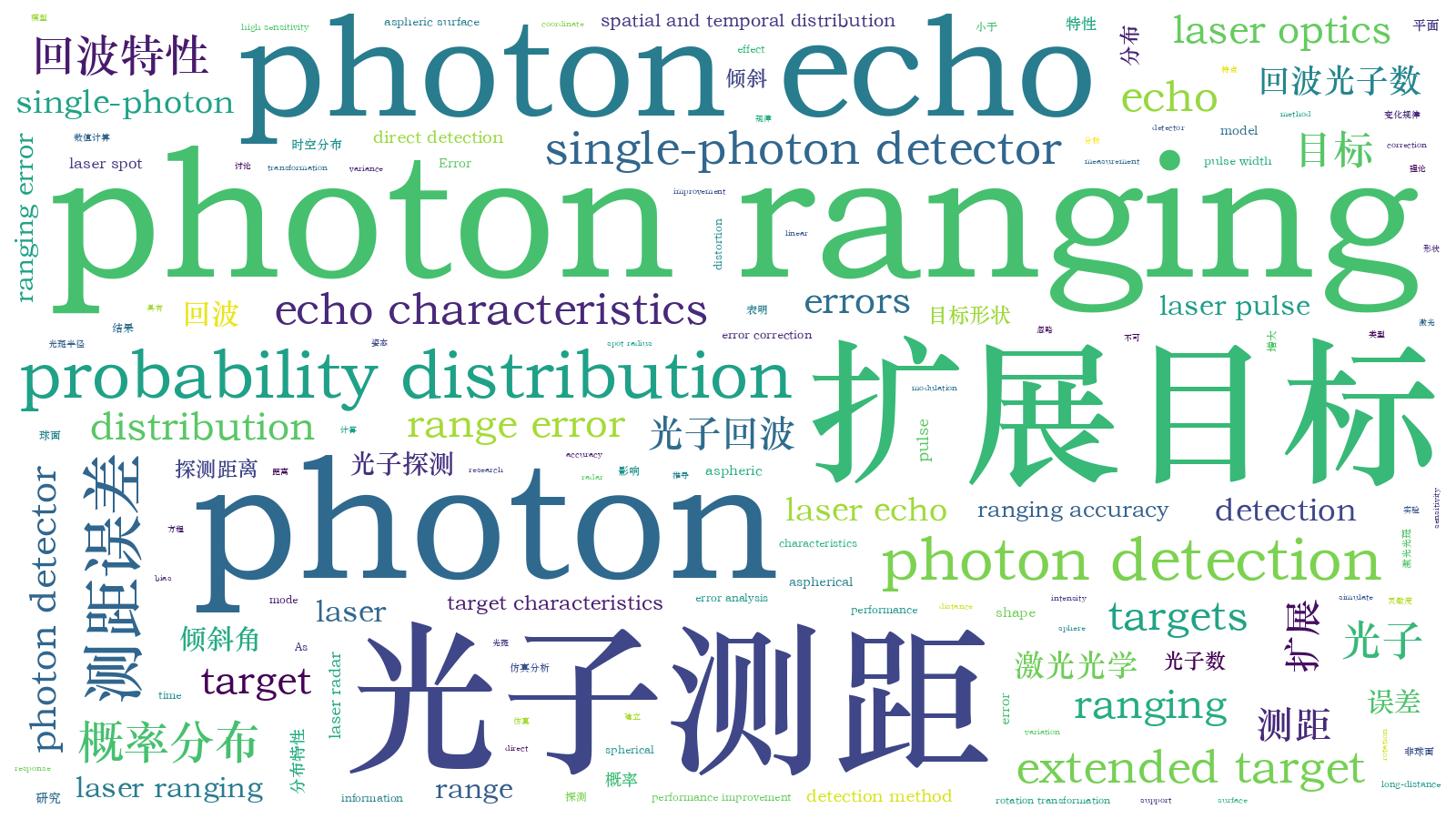扩展目标光子测距回波特性及误差研究  下载: 1184次
下载: 1184次
Objective Photon ranging exhibits the advantages of high sensitivity and long-distance detection. Compared with laser ranging in the linear mode, the photon detection exhibits the first photon bias effect owing to the dead-time of the single-photon detector, which results in greater distortion of the probability distribution of photon echo. This distortion is closely related to the intensity and distribution of the laser echo. There is a close relationship between the target shape and posture and the probability distribution of photon echo. As a result, the range errors in photon ranging caused by the target shape and posture cannot be ignored. Most researchers have focused on analyzing the modulation effect of target characteristics on the laser pulse echo. However, there is a lack of research on the range errors of extended targets in the photon-detection mode. Therefore, we discuss the relationship between the target shape and inclination and photon ranging for three typical extended targets.
Methods Based on the Poisson probability response model and the traditional laser radar equation, the probability distribution model for the photon detection of an extended target is established herein. Combining this with the coordinate-rotation transformation formula, the general probability distribution equation mixed with spatial and temporal distribution at different inclinations is derived for the three typical extended targets: a plane, a sphere, and an aspheric. Experimental results reveal that the probability distribution of this photon echo is consistent with the numerical results. We then simulate and analyze the differences in the photon echo probability distribution and laser pulse echo characteristics of the three typical extended targets. Finally, the variation between the range errors in photon detection and the types and inclinations of the extended targets is discussed theoretically.
Results and Discussions Compared with the laser pulse echo, the probability distribution of the photon echo moves forward as the inclination increases, and the variance decreases. At the same time, the pulse width of the laser echo modulated by the extended plane is wider than those of the extended spherical and aspherical surfaces. Furthermore, the probability distribution of the photon echo of the extended plane moves forward the most. The photon ranging error of the extended targets exponentially increases with the increase in inclination. The average number of echo photons is 3.9, the laser spot radius of the target is 0.2 m, and when the inclination is less than 20°, the difference in the photon ranging errors between the three extended targets is less than 1.23mm. As a result, the range errors in the photon detection caused by different extended target types could be ignored. In addition, when the inclination is greater than 20°, the photon ranging accuracy of the extended plane is most affected by the inclination, whereas that of the aspheric surface is the least affected. When the target inclination is 70°, the photon ranging errors for the extended plane and spherical and aspheric surfaces are 12.5cm,10.6cm, and 8.9cm, respectively.
Conclusions Based on the center-of-mass detection method, the range errors in the direct detection vary slightly with the inclination of the extended targets, which is negligible compared with those in photon ranging. The range errors in photon detection increase as the inclination of the target increases. The photon-ranging errors for the extension plane are most affected by the inclination. If the inclination was smaller, the photon ranging of the extended target would be almost independent of the shapes of the extended targets. These conclusions provide a theoretical basis for the photon ranging performance and error analysis and provide a reliable information support for range-error correction and performance improvement. Furthermore, the posture information of the extended target can be acquired by combining the equation of photon echo probability distribution with the measurement results of the photon echo.
1 引言
光子计数激光雷达以灵敏度高、探测距离远和测距精度高的特点广泛应用于激光测距[1-3]和目标探测[4-5]领域。由于单光子探测器死时间的存在,使得光子探测出现首光子偏置效应[6],导致光子回波概率分布产生较大畸变。在光子测距系统中,回波光子数大小和激光回波脉宽的变化对光子测距误差影响尤为明显[7-9]。Oh等[7]对光子测距误差进行了理论和实验对比,首次提出了光子测距距离漂移误差,研究了光子测距的误差和校正;黄科等[8]和Chen等[9]深入分析了点目标的回波光子数和发射激光脉宽与光子测距误差的关系,提出了校正补偿方法。上述研究侧重于分析光子探测系统发射端参数和点目标光子测距误差的关系,未考虑面目标和体目标对光子测距误差的影响。目标形状差异和目标姿态变化会引起光子回波概率分布的畸变,所导致的光子测距误差不容忽略。
李磊等[10-11]分析了脉冲展宽和平面目标的倾斜角度间的关系,并进行了激光测距回波实验验证,但未考虑发射激光空间强度分布对激光回波的影响;徐孝彬等[12-13]推导了平面目标的激光回波解析表达式,分析了发射激光和目标参数对激光测距误差的影响。上述学者偏向于给出平面目标特定的回波表达式,公式的普适性较弱,忽略了三维目标的深度信息与激光测距误差的关系。谢庚承等[14]研究了简单飞行目标的姿态变化与脉冲激光测距回波特性和测距误差的关系;Steinvall[15],Li等[16],Hao等[17],Xu等[18]对简单三维目标的脉冲激光回波分布进行了数值仿真和实验验证。上述研究主要是激光雷达直接探测模式下的目标特性和回波分布的关系分析,强调目标特性对脉冲激光回波的调制作用,缺乏光子探测模式下扩展目标的测距误差相关研究。
因此,针对扩展平面、球面和非球面三种目标,本文建立了扩展目标的光子探测回波概率模型,推导了倾斜目标的光子回波概率分布方程;通过实验验证了理论模型的正确性;仿真对比分析了光子回波概率分布和激光脉冲回波特性的异同,讨论了不同扩展目标的光子测距误差与目标倾斜角的变化规律。
2 光子探测回波概率分布模型
光子测距系统扩展目标的坐标系如
式中:τ=WFWHM/1.22,WFWHM为发射激光的半峰全宽。
当激光垂直入射目标表面时[13],单个目标面元的脉冲响应,可忽略脉冲展宽,仅考虑时间延迟和强度衰减,表示为
式中:ρ0(x,y,z)为目标的反射率;t0为面元的时间延迟,t0=2r(x,y,z)/c,c为光速;β为面元法线与激光传输方向的夹角;g(x,y)为发射激光在xoy面的能量分布。g(x,y)表示为
式中:P为激光总功率;ω为面元处激光光斑半径,ω=ω0
则整个目标的脉冲响应为所有单元面积的积分,即h(t)=∬Sdh(t),目标的回波波形信号最终表示[18]为
式中:T0为大气单程通过率;ηt和ηr分别为发射和接收系统的系统效率;ηq为单光子探测器的探测效率;Ar为探测系统的接收面积。
目标发生姿态的变化,采用坐标变换的方法进行求解,当目标的倾斜角为α,即目标绕y轴旋转时,其变换矩阵R=
式中:
因此,在第ith时间栅格内的平均信号回波光子数Ns(i)=
式中:N(i)为第ith时间栅格内的平均回波光子数,N(i)=Ns(i)+Nn,Nn为单个时间栅格的平均噪声光子数;ddead=Ceiling
基于时间相关光子计数器(TCSPC)得到的光子测距回波概率分布,结合质心算法[8-9],可得光子探测的时间均值
光子探测的光子回波概率分布相较于激光脉冲回波前移的距离定义为光子测距的距离漂移
3 实验与光子测距误差分析
为验证模型推导理论的正确性,搭建了光子计数激光雷达测距系统,进行了扩展平面目标光子测距实验,获得了扩展平面的光子回波概率分布。脉冲激光波长为1064nm,单脉冲能量为5μJ,脉宽为9ns,目标与光束垂直,时间栅格为16ps,光子测距系统示意图和光子测距系统的现场图如

图 2. 光子测距系统。(a)光子测距系统示意图;(b)光子测距系统现场实验图
Fig. 2. Photon ranging system. (a) Schematic of photon ranging system; (b) experimental diagram of photon ranging system
3.1 扩展目标的回波特性分析
扩展目标可分为平面、球面和非球面三大类。扩展目标的不同样式会导致激光测距和光子测距产生误差,设置光子计数激光雷达的时间栅格为16ps,发射激光半峰全宽为100ps,单脉冲能量为1 nJ,发散角为0.02 mrad,探测距离为10 km,扩展目标为朗伯体,反射率为0.9。
扩展平面采用直角坐标系进行求解,平面目标的不同倾斜角的雅克比行列式
式中:C=1/R0,R0为曲面顶点处的曲率半径;S2=x2+y2;B=

图 4. 扩展目标的激光脉冲回波和光子回波概率分布。(a)(b)扩展平面;(c)(d)扩展球面;(e)(f)扩展非球面
Fig. 4. Laser pulse echo and photon echo probability distribution of extend targets. (a)(b) Extended flat; (c)(d) extended sphere; (e)(f) extended aspheric
如
3.2 扩展目标的测距误差分析
为定量描述不同扩展目标的姿态对光子测距的影响,利用质心算法获得目标的测量距离,平面、球面和非球面三种扩展目标的距离漂移误差如

图 5. 扩展目标的距离漂移误差。(a)平面;(b)球面;(c)非球面
Fig. 5. Distance drift error of extended targets. (a) Flat; (b) sphere; (c) aspheric
如
表 1. 扩展目标不同倾斜角的平均回波光子数
Table 1. Average number of photon echo at different tilt angles of extended targets
| ||||||||||||||||||||||||||||||||||||||||||||
三种扩展目标的光子测距误差变化趋势相似,为进一步对比不同扩展目标的测距性能,其测距误差的结果如
由
4 结论
本文建立了扩展目标光子探测回波概率模型,利用扩展目标的反射特性、目标形状及倾斜角等信息,推导了光子回波概率分布方程。该模型亦适用于非扩展目标。通过搭建扩展平面的光子测距实验系统,验证了模型的正确性。对比分析了光子回波概率分布与激光脉冲回波间的异同,在此基础上,讨论了扩展平面、球面和非球面三种目标的光子测距误差与倾斜角间的变化规律。结果表明:相较于激光脉冲回波,光子回波概率分布随着倾斜角的增大整体前移,方差增加幅度较小;基于质心算法,直接探测距离误差随扩展目标姿态倾斜角的变化幅度较小,最大测距误差为1.4cm,相较于光子测距误差,其可忽略不计;光子测距的误差随着目标倾斜角的增大逐渐增大,扩展平面目标受倾斜角影响最大,可达12.5cm;当倾斜角小于20°时,扩展目标的光子测距与扩展目标的形状几乎无关。这些结论为光子测距性能和误差分析提供了理论依据,为测距误差修正和性能提升提供了可靠的信息支撑。进一步地,结合文中的光子回波概率分布方程与实际光子回波测量结果,亦可反演出扩展目标的姿态信息。
[1] 罗远, 贺岩, 耿立明, 等. 基于光子计数技术的远程测距激光雷达[J]. 中国激光, 2016, 43(5): 0514001.
[2] 黄科, 李松, 马跃, 等. 单光子模式激光测高探测概率模型与精度分析[J]. 中国激光, 2016, 43(11): 1110001.
[3] 刘鸿彬, 李铭, 舒嵘, 等. 少光子灵敏度精密激光测距方法及验证[J]. 红外与激光工程, 2019, 48(1): 0106001.
[4] 丁宇星, 李永富, 刘鸿彬, 等. 基于InGaAs探测器的日光条件光子计数实验[J]. 中国激光, 2018, 45(11): 1104003.
[8] 黄科, 李松, 马跃, 等. 单光子激光测距的漂移误差理论模型及补偿方法[J]. 物理学报, 2018, 67(6): 064205.
[10] 李磊, 胡以华, 赵楠翔, 等. 激光遥感目标回波脉宽展宽特性实验[J]. 红外与激光工程, 2010, 39(2): 246-250.
[11] 赵楠翔, 胡以华, 雷武虎, 等. 激光回波波形分析小目标检测成像方法[J]. 红外与激光工程, 2009, 38(4): 748-752.
[12] 徐孝彬, 张合, 张祥金, 等. 脉冲激光探测平面目标特性对测距分布的影响[J]. 物理学报, 2016, 65(21): 210601.
[13] 徐孝彬, 张合, 陈杉杉. 脉冲激光周向探测平面目标回波特性[J]. 光学学报, 2017, 37(4): 0414003.
[14] 谢庚承, 叶一东, 李建民, 等. 脉冲激光测距回波特性及测距误差研究[J]. 中国激光, 2018, 45(6): 0610001.
[16] Li Y, Wu Z. Targets recognition using subnanosecond pulse laser range profiles[J]. Optics Express, 2010, 18(16): 16788-16796.
[22] Gatt P, Johnson S, Nichols T. Dead-time effects on Geiger-mode APD performance[J]. Proceedings of SPIE, 2007, 6550: 65500I.
侯阿慧, 胡以华, 赵楠翔, 方佳节, 张鑫源. 扩展目标光子测距回波特性及误差研究[J]. 中国激光, 2021, 48(4): 0401016. Ahui Hou, Yihua Hu, Nanxiang Zhao, Jiajie Fang, Xinyuan Zhang. Echo Characteristics and Error of Extended Target for Photon Ranging[J]. Chinese Journal of Lasers, 2021, 48(4): 0401016.









